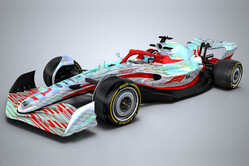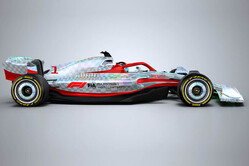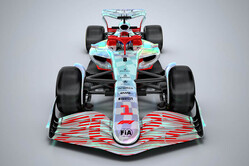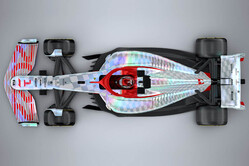


15/07/2021
NEWS STORY
 F1 gives fans first glimpse of the look of 2022 as it presents full size model at Silverstone.
F1 gives fans first glimpse of the look of 2022 as it presents full size model at Silverstone.
The car was unveiled in the same slick, yet entirely formulaic, style that has become the norm for team launches; strobe lights, smoke (mirrors?), pulsating music and smiling presenters.
Once the car was revealed, we were treated to the sight of the current crop of drivers - all suited, booted and carrying their helmets (!) - as they looked on at the car they will be driving next season, and while we never got to hear the opinion of the likes of Kimi or Seb, others appeared moderately impressed and stuck to the script
Explaining the reasoning behind the rules overhaul, Nicholas Tombazis and Pat Symonds were keen to point out that the quality of the racing may not improve from the outset but will probably take time as they effectively played Liberty’s get out of jail card.
The philosophy behind the aerodynamics overhaul was previously explained in this 2019 video by Rob Smedley at a time it was intended to introduce the new look in 2021, before the pandemic.
{youtube eBX7lPk5qmA 560x315}
Basically the intent is to create more wheel-to-wheel racing and more action on the track. To this effect, the project was run using Computational Fluid Dynamics (CFD) and thousands of computer cores on Amazon Web Services (AWS), saving F1 both time and money to deliver the new design.
Currently, F1 cars face a loss of downforce while racing close to each other, with a following car losing as huge amounts of its downforce when racing closely behind another.
 This next-generation car will run on 18-inch wheels with low-profile tyres for the first time and will feature wheel wake control devices, a brand-new bodywork design with a new front wing shape, simplified suspension, new rear-end layout, and underfloor tunnels.
This next-generation car will run on 18-inch wheels with low-profile tyres for the first time and will feature wheel wake control devices, a brand-new bodywork design with a new front wing shape, simplified suspension, new rear-end layout, and underfloor tunnels.
The intended result is to significantly reduce downforce loss when following another car closely, in turn creating more intense racing and excitement on the track.
The key goal of F1 in redesigning the car is to increase wheel-to-wheel racing between cars that is currently restricted due to the loss of downforce.
This new design change helps reduce the turbulent airflow from the car in front, in turn increasing the downforce (and, therefore, the performance) of the following car and allowing them to close the gap for a chance to overtake the leading car.
"We want to make it more possible for cars to race each and follow each other and to have more exciting battles," explained Tombazis. "We want to have tyres that enable people to fight each other without degrading or only giving a short interval for the person attacking to attack.
"They are simpler than the current cars because a lot of the small components have been removed, especially in front of the sidepods, the front wings are simpler.
"There is a diffuser going right under the car, a venturi channel type manner. There are tunnels under the sidepods from the front to the back."
 The CFD project used over 1,150 AWS compute cores to run detailed simulations of over 550 million data points that model the impact of one car's aerodynamic wake on another. Using the unmatched scalability of AWS, F1 was able to reduce the average time to run simulations by 80%, from 60 hours down to 12 hours.
The CFD project used over 1,150 AWS compute cores to run detailed simulations of over 550 million data points that model the impact of one car's aerodynamic wake on another. Using the unmatched scalability of AWS, F1 was able to reduce the average time to run simulations by 80%, from 60 hours down to 12 hours.
"Right in the beginning of this project, our main aim was to get cars that race closer together,” said Pat Symonds. "Running in the cloud and running with AWS really removed all the barriers of time and computing capacity and allowed us to run what we want, when we want, and how we want. This is something I think I wouldn't have believed was possible unless I'd been able to really leverage that power of AWS and see where the future might lie."
To redesign its cars, F1 needed to move away from its on-premises technology environment, where it used CFD along with wind tunnel testing to design and test the aerodynamic properties of cars. F1 moved its CFD simulation environment to a high performance computing (HPC) platform on AWS using Amazon Elastic Compute Cloud (Amazon EC2) instances to run complex simulations that visualize the wake turbulence of cars and the impact on following cars. F1 chose to use a combination of Amazon EC2 C5n instances and the new AWS Graviton2-based C6g instances to gain maximum flexibility in terms of pricing and performance.
 Along with reducing its simulation time from days to hours, F1 lowered the cost of running these workloads by 30% by using the AWS Graviton2-powered instances.
Along with reducing its simulation time from days to hours, F1 lowered the cost of running these workloads by 30% by using the AWS Graviton2-powered instances.
"The recent release of AWS Graviton2 has allowed us to really optimize other jobs and has achieved about a 30% cost savings for us at the moment. And I actually see that going further. I'm sure we can move towards 40% cost savings compared to our old methods of doing things," said Symonds. "By working with AWS, we really have access to a huge environment, and I'm not just talking about physical environment of compute power, but some really, really great people to work with. Some people who push us just as much as we push them."
Check out our gallery, here.